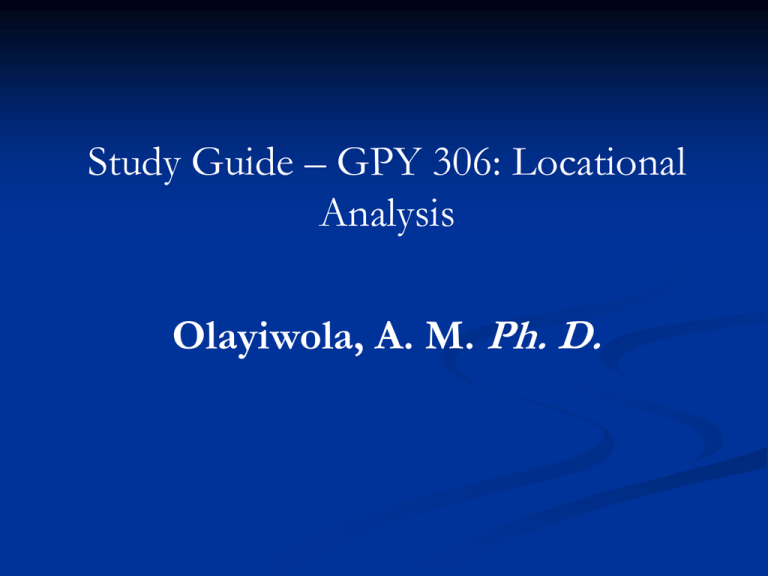GPY 306: Locational Analysis
advertisement

Study Guide – GPY 306: Locational Analysis Olayiwola, A. M. Ph. D. 1. Course Information General Information: Students in this course should read this study guide carefully at the start of semester. It contains important information about the course. If anything in it is unclear, please consult one of the teaching staff on the course. Learners are expected to register for this course within the time frame specified on the student’s information board. available on _________. Course Code & Course Name: GPY 306: Locational Analysis Credit points: 3 units Year: 300 level Semester: 2nd/Rain About the Course This course introduces students to the development of theories of spatial structure and processes. Prerequisites GPY 305: Philosophy and Methodology in Geography Lecturer Information: Course Lecturer: A. M. Olayiwola Email: olaadewale@yahoo.com Consultation: This will be through, SMS messages, email, or by blogging. 2. Introduction to the Course You are welcomed to GPY 306. This is an online course that runs in the distance learning mode. It is a compulsory course opened to all students in the Department of Geography. It is a 3-credit course that will require 45 hours of interaction among teachers and learners for the period of the course. Location of socio-economic activities has become an integral part of economic geography, regional science, and spatial economics. Locational analysis addresses the questions of what economic activities are located where and why. This course will help you gain insight into location behaviour of socio-economic services AIM The aim of this course is to introduce learners to the location behaviour of socio-economic activities 3.Learning Objectives At the end of this course learners will be able to, 1. explain the meaning of location 2. identify and explain the theoretical foundation of settlements’ distribution 3. assess the relevance of theories of industrial location to the distribution and spatial structure of Nigerian manufacturing activities 4. discuss the major factors influencing the location of socio-economic activities. 4. Symbols and Acronyms There are no symbols and acronyms in this course 5. Taking the Course There will be 15 lecture units arranged into 5 modules. The course will be taught using the asynchronous method. On weekly basis for 15 weeks. A lecture unit will be uploaded on the course blog for the learners to access. Support CDs will be made available to on registration Pretest will be administered preceding each lecture to assess basic knowledge in the subject matter. Performance of learners in pretests will not count in the final examination grades Practice tests will be administered at the end of each lecture unit for learner’s self assessment and revision. 5 tutor-marked assignments (multiple choice) will be provided for each module At a particular period in each week, learners will be expected to participate in a chat or a discussion forum The schedule for a chat/discussion forum will be communicated to learners. List of frequently asked questions (FAQ) and answers will be made available to learners. List of suggested readings will be made available to learners Additional instructions to facilitate learning may be provided by teachers as deem necessary Learners must participate in 75% of the chat/forum to qualify for the exam to qualify for the final examination Taking the practice test improves your chances of success in the course Tutor-marked assignment accounts for ____% of the final grade for the course, so submit promptly! 6. How to prepare for the final examination for this course This study guide provides an in-depth knowledge needed by learners to successfully take the final examination. Learners are encouraged to read and understand the entire content to ensure good performance in this course. Learners should make use of the supplemental CDs provided as this will expand the knowledge of the learner. Learners should note that the sample questions and practice tests provided at the end of each lecture will help learners to assess self and promote revision before taking the final examination. Suggested readings will enhance learner’s performance in the final examination. 7. Prerequisites for Examination For any learner to be eligible to sit for the final examination in this course, he/she must fulfill the following requirements Participated in at least 75% of all online interactions 8. Preparatory Questions In which of the following ways is the ‘Least Cost’ approach useful to industrial location? (a) managerial capability (b) optimum location (c) specialization of labour (d) expansion of local market A major weakness of the core-periphery interaction model is (a) rigidity (b) narrow scope (c) incoherence (d) impracticability After each question, the answer should immediately follow along with an explanation on why that answer is the correct answer. Distribution and spacing of Nigerian urban centres can be likened to Walter Christaller’s Central Place Theory – True or False _______ 9. Assessment Assessment in this course will be done considering active participation of learners in all interactive sessions, quality of written assignments, records of materials used as references in all assignments, regular feedback from teachers and learners and performance in examinations. Details of assessment strategies are as follow: Part A 1. Continuous Assessment: a. Assignment: individual term papers, group reports: (20%). b. 2. Tutored marked assignment (20%) End of course examination: a. This comprises 120 multiple choice objective questions. (60%) 9b. Feedback and advice: Feedback will be from teachers to learners (you) and learners (you) to teachers. The Course has a feedback blackboard available on _________ (show the hyperlink). All assignments have information about deadlines for submission after which submissions by students will be automatically rejected. Results of all assignments (scores) will be released within 72 hours of the deadlines. Summary of records of learners’ participation in all online sessions will be presented on the feedback blackboard for the course Learners can also share information with peers on the feedback blackboard Students are required to submit their proposed topics for term papers on the assignment All student have a course adviser that can be contacted through their e-mail address for information, clarifications and support Exam arrangements All examinations shall be conducted physically. Continuous assessment a. Assignments: individual term papers, group reports: List of assignments for each topic is available on the content area of the course End of course test will be one hour and students will be informed a fortnight before it takes place. End of topic short tests comes with seven days of completing the topic. End of course test takes one hour and students will be informed of when to log on to do the test. Questions are withdrawn at the end of one hour after the questions would have been presented online. The results are released automatically End of course examination: This comprises 160 multiple choice questions covering all topics covered in the course (40%) Time allotted for this examination is 1 hour 30 minutes and it follows the same format as done with the end of topic tests. Verification of Integrity of Submitted Assignments and Guidelines for Written Assignments A. The integrity of submitted written assignments would be determined by the following A. B. C. D. Compliance with standards of writing considering English (grammar and tenses, construction), Appropriate formatting, Adoption of appropriate referencing format, Adequate referencing and documentation of all materials used in doing the assignment). Copying of each others work by students automatically imply zero scores for the students involved . Avoidance of Plagiarism: Plagiarism involves using the work of another person and presenting it as one's own.’ Plagiarism is a serious breach of the ODL’s rules and carries significant penalties. Penalties in this course would result to failure in the course, and/or referral to the Open Distance Learning Disciplinary Committee. 10. Glossary In this section, list (in alphabetical order) all the definitions to all terms, jargon, unusual wording and expressions found within the text. 11. Index / Tagging Here, list (in alphabetical order), important terms, names, places, events, and topics along with the page numbers where they are mentioned.







